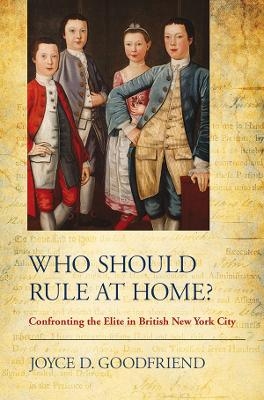
Who Should Rule at Home?
Cornell University Press (Verlag)
978-0-8014-5127-0 (ISBN)
In Who Should Rule at Home? Joyce D. Goodfriend argues that the high-ranking gentlemen who figure so prominently in most accounts of New York City's evolution from 1664, when the English captured the small Dutch outpost of New Amsterdam, to the eve of American independence in 1776 were far from invincible and that the degree of cultural power they held has been exaggerated. The urban elite experienced challenges to its cultural authority at different times, from different groups, and in a variety of settings.
Goodfriend illuminates the conflicts that pitted the privileged few against the socially anonymous many who mobilized their modest resources to creatively resist domination. Critics of orthodox religious practice took to heart the message of spiritual rebirth brought to New York City by the famed evangelist George Whitefield and were empowered to make independent religious choices. Wives deserted husbands and took charge of their own futures. Indentured servants complained or simply ran away. Enslaved women and men carved out spaces where they could control their own lives and salvage their dignity. Impoverished individuals, including prostitutes, chose not to bow to the dictates of the elite, even though it meant being cut off from the sources of charity. Among those who confronted the elite were descendants of the early Dutch settlers; by clinging to their native language and traditional faith they preserved a crucial sense of autonomy.
Joyce D. Goodfriend is Professor of History at the University of Denver. She is the author of Before the Melting Pot: Society and Culture in Colonial New York City, 1664–1730, editor of Revisiting New Netherland: Perspectives on Early Dutch America, and coeditor of Going Dutch: The Dutch Presence in America, 1609–2009.
Introduction: The Pan-ethnic Elite and the Problem of Cultural Authority
Part I. The Indigestible Dutch
1. The Crystallization of an Anti-Dutch Narrative
2. From Nation to Linguistic Community
Part II. Pious Commoners
3. George Whitefield Awakens New York City
4. Becoming Religious Consumers
Part III. Defiant Dependents
5. "Master of the House"?
6. Attached to the Household
7. Sabotaging the Civilizers Conclusion: Tipping the Cultural Scales
| Erscheinungsdatum | 12.03.2017 |
|---|---|
| Zusatzinfo | 14 Halftones, black and white |
| Verlagsort | Ithaca |
| Sprache | englisch |
| Maße | 152 x 229 mm |
| Gewicht | 907 g |
| Themenwelt | Geisteswissenschaften ► Geschichte ► Regional- / Ländergeschichte |
| ISBN-10 | 0-8014-5127-2 / 0801451272 |
| ISBN-13 | 978-0-8014-5127-0 / 9780801451270 |
| Zustand | Neuware |
| Haben Sie eine Frage zum Produkt? |
aus dem Bereich


